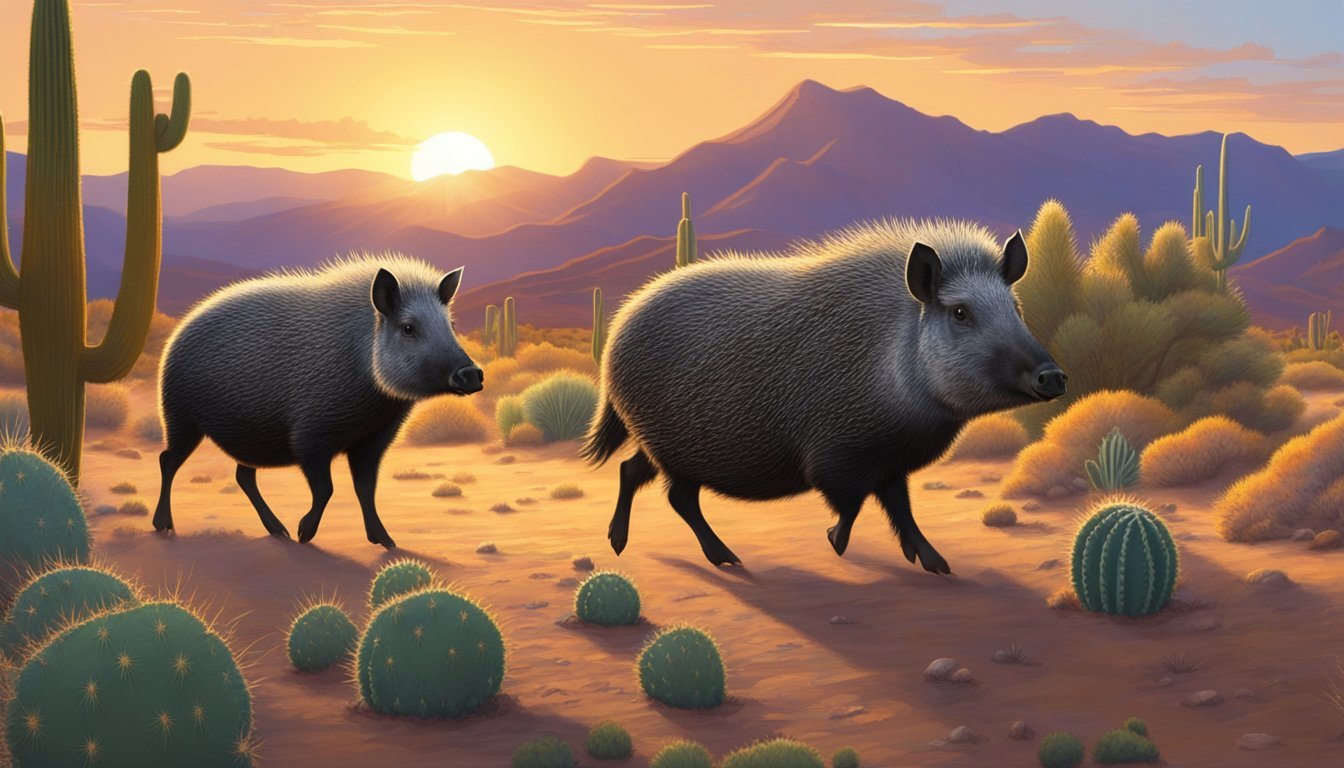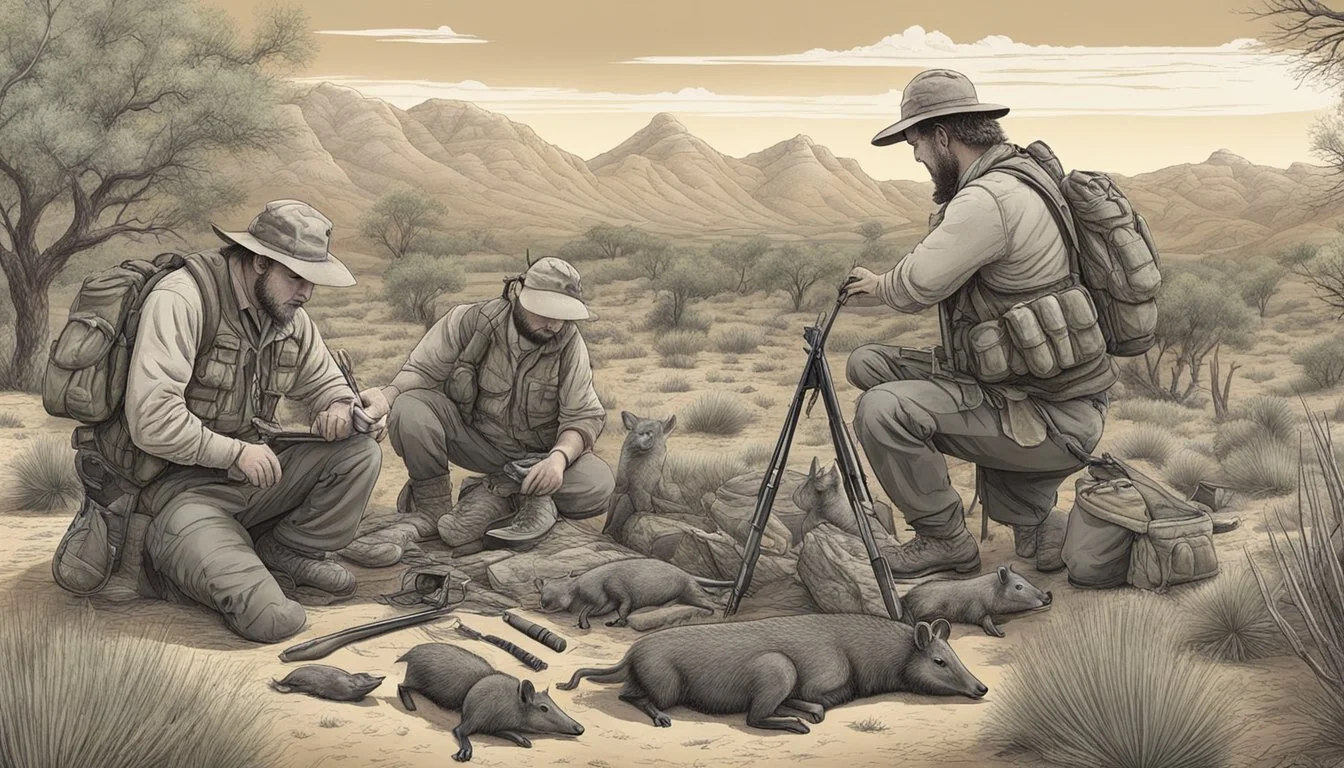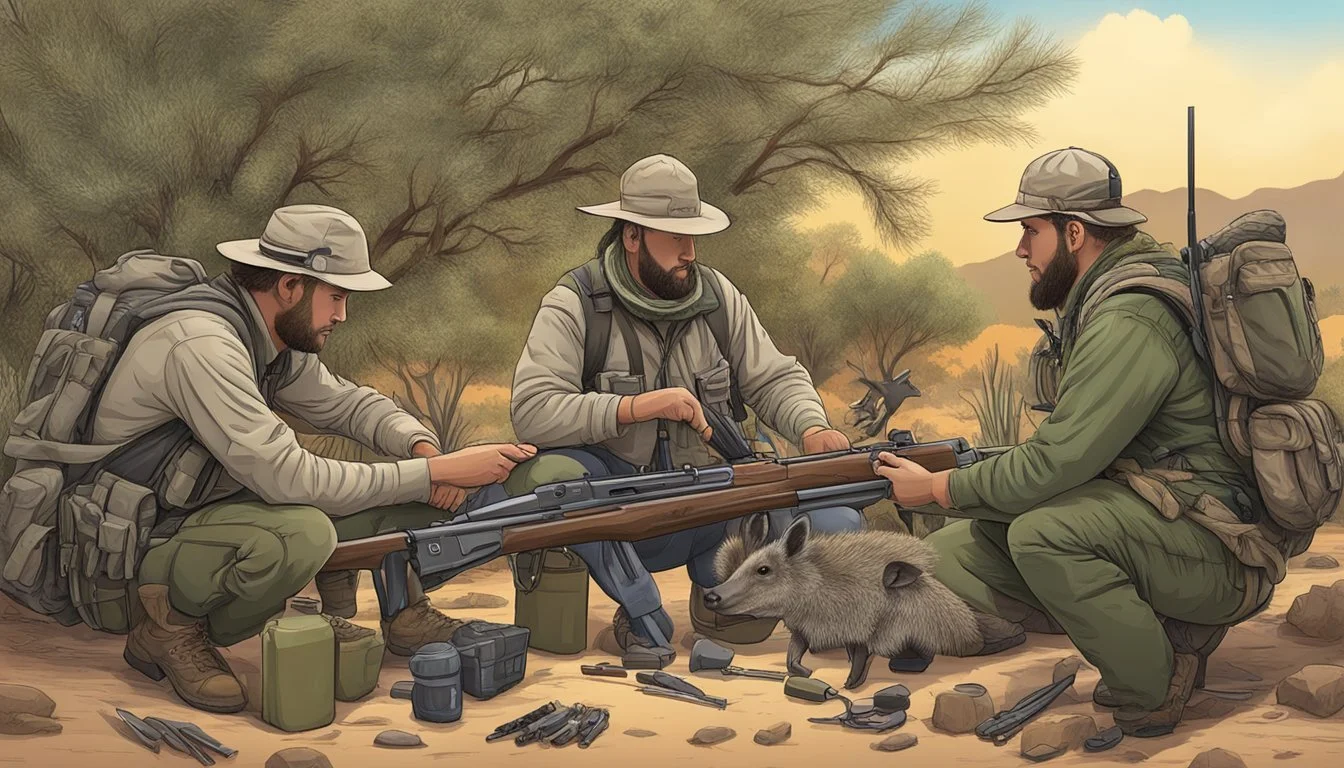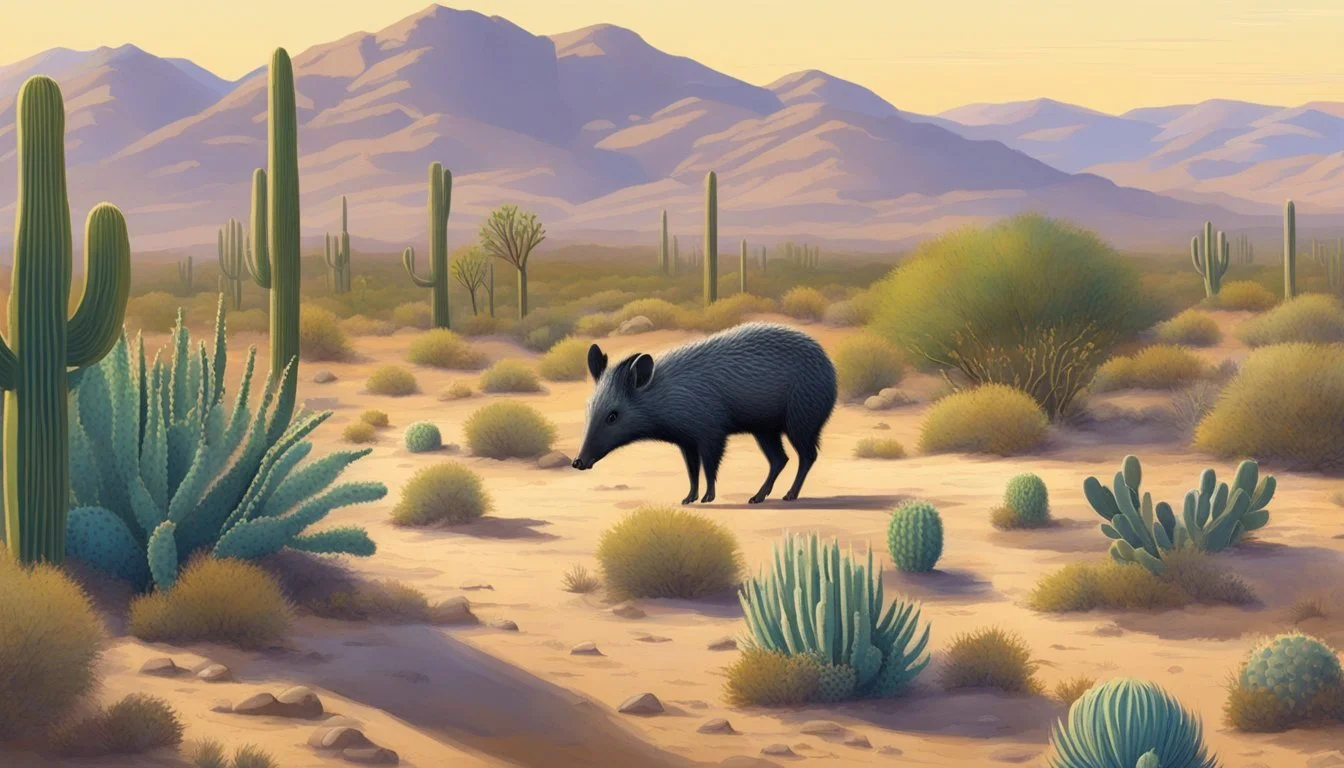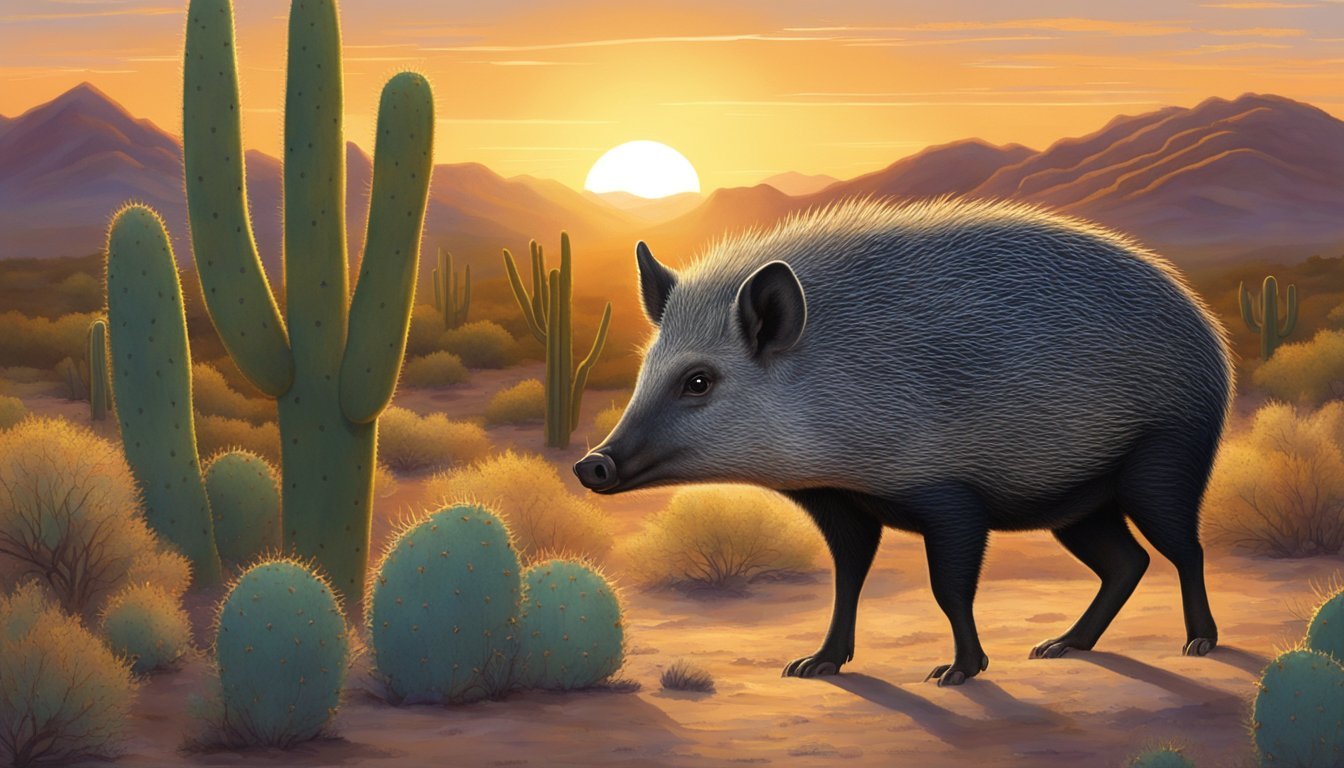Javelina Hunting Seasons
Essential Dates and Regulations
This Article is Part of Our Guide on Hunting Seasons for Over 70 Common Game Species
Javelina, also known as collared peccary or skunk pig, present a unique hunting opportunity in Arizona. These creatures, resembling wild hogs but not biologically true pigs, offer hunters a distinct experience due to their habitat and behavior. Arizona's diverse wildlife resources afford hunters a range of game, and the javelina stands out as an intriguing target during its specific hunting seasons.
Arizona's javelina season kicks off in January with an archery-only segment and continues through late February with various hunting methods allowed. Different hunts are designated for specific weapon types such as firearms, archery, and even a combination category labeled HAM (Handgun, Archery, and Muzzleloader). The state's game and fish department closely manages these seasons to ensure sustainable hunting opportunities for current and future generations. Hunters must navigate regulations that govern the season dates, legal methods of take, and areas open for javelina hunting to participate ethically and legally in this activity.
Understanding the behavior of the javelina is crucial for a successful hunt, with spot and stalk being a primary tactic. The animals are well-adapted to the desert environment, using camouflage to blend into their surroundings. Therefore, hunters often employ glassing—using binoculars or other optics—to locate javelinas before attempting a stalk. This approach requires patience and a sound strategy, as the animals' natural coloration and the terrain's characteristics can make spotting them a challenge.
Understanding Javelina
In pursuing the elusive Javelina, or collared peccary, hunters should acquaint themselves with the animal's distinct physical traits and natural habitats. These factors are crucial in tracking and understanding their behavior in the wild.
Physical Characteristics
The collared peccary, commonly referred to as a Javelina, possesses several distinctive features. Its body is stout, supported by short, powerful limbs, and covered in bristly hair. Notably, a Javelina has a prominent mane running down its back which stands erect when the animal is agitated. They exhibit a grayish-black coloration with a white "collar" around the neck, from which their name is derived.
Their most characteristic physical feature is the snout, which ends in a disc-shaped nose. Javelina's tusks are actually elongated canine teeth that sharpen against each other and are visible when the mouth is open. The tusks, along with their keen sense of smell provided by a well-developed scent gland located on their back, are critical for their survival in the wild.
Natural Habitat
Javelinas have adapted to various environments but primarily inhabit deserts and scrublands. They are found in the southwestern United States, particularly in New Mexico, Arizona, and Texas, and extend into Central and South America.
Their habitat is characterized by:
Dense brush: for cover and sleeping,
Cacti: notably the prickly pear, which is a substantial part of their diet,
Grasslands: providing additional foraging opportunities.
The animals are gregarious, frequently moving in groups called squadrons, and they rely on their odor to communicate and establish social hierarchies. The presence of water sources is another important feature of their habitat, although they get much of their hydration from the succulent plants they eat.
Javelina Hunting Basics
Javelina hunting offers a unique challenge to hunters who seek the thrill of pursuing a game animal that is both clever and elusive. Suitable planning and understanding of legalities, as well as mastering various hunting techniques and gear, are essential for a successful hunt.
Legal Definitions and Classifications
Javelina, also known as collared peccary, are classified as big game animals in several states and require a hunting license to pursue. States with significant javelina populations often have specific seasons and regulations governing how they may be hunted. It is the hunter's responsibility to check with local wildlife agencies for the most current rules, which can include:
Open hunting seasons, typically outside fawning or birthing periods to ensure healthy population control.
Restrictions on the type of weapons allowed; commonly, hunters may use handguns, archery equipment, and muzzleloaders.
Bag limits and gender restrictions to promote sustainable hunting practices.
Essential Gear and Techniques
Javelina hunters must be well-equipped and skilled in various hunting practices. Essential gear includes items for spot and stalk methods, such as quality binoculars for glassing and durable camouflage clothing for stalking. Footwear should provide both stealth and snake protection. The gear list often includes:
Binoculars for distant observation.
Camouflage clothing, to blend in with the terrain.
A reliable weapon suited to the hunter's preference and legal regulations.
Successful techniques rely on a hunter's ability to remain undetected and their proficiency in close-quarter hunting. Stalking skills are paramount, as javelina possess a keen sense of smell. Hunters should approach downwind and remain silent. The most practiced techniques include:
Glassing from high vantage points to spot herds.
Careful stalking to get within range for a clean and ethical shot.
Spot and stalk, a popular method where hunters locate javelina from a distance and plan a stealthy approach.
A systematic combination of planning, legal knowledge, proper gear, and refined hunting skills makes javelina hunting a rewarding sport for the seasoned and novice hunter alike.
Hunting Seasons and Regulations
In the Southwestern United States, particularly in states like Arizona, Texas, and New Mexico, hunting javelina is a regulated activity with specific seasons, bag limits, and eligibility criteria for hunters.
Seasonal Timing and Limits
Arizona: The Arizona Game and Fish Department outlines that javelina hunting seasons typically start in January, with opportunities for archery hunters, followed by handgun, archery, and muzzleloader (HAM) seasons, and concluding with general rifle seasons. For the 2024 Spring season, the application deadline is in October, and hunters can apply for tags through a draw system.
Season Dates: The exact season dates can vary; however, as per 2024 regulations, spring turkey, javelina, bison, bear and raptor capture seasons are included in the department's regulation booklet.
Bag Limits: Hunters are often limited to one javelina per tag, but this can change based on the management decisions for the season.
Texas: Texas Parks & Wildlife Department regulates the javelina seasons by county. The season typically spans several months allowing hunters ample time to participate.
Season Dates: Each county in Texas may have different opening and closing dates for javelina hunting, so it's imperative to check local regulations.
Bag Limits: Texas also sets bag limits which can range from one to two javelina per license year depending on the county.
New Mexico and Other States: Similar to Texas and Arizona, other states such as New Mexico have their own set seasons and limits, which are subject to change annually. Hunters should check the latest regulations before planning their hunts.
Licenses and Hunter Eligibility
Licenses: To hunt javelina, individuals must have the appropriate hunting license for their state. In Arizona and Texas, non-residents can apply for and purchase hunting licenses, but they may experience different costs and availability of tags.
Arizona: Licenses can be purchased online, at department offices, or at licensed retailers.
Texas: Hunters can buy their licenses online through the Texas Parks & Wildlife Department or at various retail outlets.
Hunter Eligibility: Certain states have special provisions for youth hunters and requirements for hunter education. For example, Arizona requires that hunters born after January 1, 1969, must complete a hunter education course before purchasing a license.
Operation Game Thief: Both Arizona and Texas run Operation Game Thief, a program that allows citizens to report wildlife violations. Violations can severely impact draw odds and hunting privileges.
Draw Odds: Successful draw odds for javelina tags can vary greatly. Hunters should research the odds when applying for tags, as limited numbers of permits are often issued.
Hunters need to be aware that the violation of hunting regulations can lead to serious consequences, including fines and revocation of hunting privileges. For detailed and updated information on seasons, regulations, and hunter eligibility, always consult the respective state's game and fish department resources.
Practical Hunting Strategies
Successful javelina hunting relies on precise tactics attuned to the quarry's habits and habitat. These strategies enhance a hunter's chance of a successful hunt by combining stealthy movement, thoughtful observation, and an understanding of the javelina's environment.
Spot and Stalk Techniques
Spot and stalk hunting is a tried-and-true method for javelina, which involves locating the animals from a distance and then carefully closing in for a shot. For effective spot and stalk, hunters should:
Utilize binoculars or a spotting scope (glassing) to scan across likely javelina habitats like areas rich with prickly pear cactus and mesquite beans.
Identify fresh signs such as rooted-up ground or overturned cow pies which indicate a javelina's presence.
Move quietly and remain downwind to avoid detection, as javelinas have a keen sense of smell.
When found, hunters must approach javelinas with caution, using natural cover to avoid being seen and applying patience until a clean shot presents itself.
Habitat-Specific Tips
Understanding the preferred habitats of javelinas can greatly improve hunting success. In the field, consider the following:
Javelinas frequent arid environments where they can find their staple foods: tubers, roots, and prickly pear cacti.
They often bed down in thick brush or coverage that protects them from the elements, so scouting such areas is key.
It's crucial to adapt to the area's topography; in dense vegetation, move slowly, and in open areas, use ridgelines or other raised features for glassing. Javelinas are not as elusive as deer, elk, or turkey, making them more accessible for hunters willing to brave the thorny landscape where they thrive.
Javelina Conservation and Management
Effective conservation and management practices are vital to sustain healthy javelina populations within their natural habitats. These practices aim to balance the species' survival with human interests, such as hunting.
Population Control Initiatives
Javelina, also known as collared peccaries, are subject to specific management efforts to regulate their numbers in the wild. In Arizona, the Arizona Game & Fish Department (AZGFD) sets annual hunting seasons and bag limits to prevent overhunting and to help maintain a stable javelina population. Predator species like coyotes and mountain lions, which naturally prey on javelinas, also play a critical role in population control. Hence, management strategies often consider the complex dynamics between these wildlife species.
List of control initiatives:
Structured hunting seasons
Predation monitoring
Enforcement of bag limits
Habitat Preservation Efforts
Conservation endeavors to protect javelinas include safeguarding their habitats — predominantly deserts, chaparral, and oak-grasslands. These efforts involve assessing environmental impacts and advocating for land policies that promote the preservation of these areas. Javelinas have a keen sense of smell, which they rely on for foraging and detecting danger, highlighting the importance of maintaining their natural habitats with minimal human interference.
Essential aspects of habitat efforts:
Land-use policy development: Ensuring that development does not encroach on crucial javelina habitats.
Research and monitoring: Studying javelina behavior and habitat use to inform conservation strategies.
Management and conservation initiatives target the sustainable coexistence of javelinas with their ecosystem and human neighbors, ensuring the species' prosperity for future generations.
Preparation and After the Hunt
The successful javelina hunter understands that the hunt encompasses more than just the pursuit. It includes meticulous field dressing and meat processing, as well as adhering to ethical standards and responsible practices throughout the hunting process.
Field Dressing and Meat Processing
Once a javelina is harvested, field dressing should commence as soon as possible to preserve the quality of the meat. Hunters should:
Wear gloves to maintain hygiene and prevent disease transmission.
Remove the entrails carefully to prevent contamination of the meat, paying special attention to avoid puncturing the intestines.
Skin the animal, which can be more difficult than with other big game due to the javelina's coarse hair and tough hide.
Cool the meat swiftly to inhibit bacterial growth. Blocks of ice can be used if a refrigerator is not immediately available.
Meat Processing should occur in a clean environment. Aging the meat in a controlled setting for a few days enhances tenderness and flavor. The javelina’s ham and other cuts can then be processed for cooking. While some hunters may possess the skills to process the meat themselves, others might opt for professional services, ensuring that the game is handled properly.
Hunting Ethics and Responsible Practices
Ethical hunting is pivotal not only for conservation but to maintain public support for the hunting community. This involves:
Pre-Hunt Preparation: Scouting and using spot and stalk methods are preferred for javelina hunts, as they allow hunters to minimize disturbance to the animal and its habitat.
Respect for Wildlife: Harvesting only when there is a clear, ethical shot ensures a swift and humane kill, reducing the animal’s suffering.
Responsibility: Hunters should obtain all necessary permits, follow bag limits, and hunt only during designated seasons. They should also ensure they are on public land or have explicit permission to hunt on private land.
Moreover, hunters should exhibit an interest in understanding javelina behavior, habitat, and food sources like corn, which can influence their movements and patterns. Taking only what they need and utilizing as much of the animal as possible are also fundamental aspects of responsible javelina hunting practices.
Location-Specific Hunting Information
When hunting Javelina, it's important to consider the specific regulations and environments of the region. Arizona and Texas offer distinct habitats and hunting experiences for this unique game species.
Arizona Javelina Hunts
In Arizona, Javelina can be found throughout the desert landscapes, particularly in areas with abundant prickly pear cactus which they frequently consume. Hunting seasons here can vary each year but typically include a general season and several archery and youth-only seasons. Permits can be obtained through a lottery system known as a draw:
General Season: Usually runs from late January to early February.
Archery-Only: Held earlier in the year, often starting in December.
Youth-Only: Provides special opportunities outside of general seasons.
Arizona Game and Fish Department manages the hunts, and hunters are encouraged to check their regulations for specific dates and unit numbers where Javelina can be legally hunted.
Texas and Beyond
Texas has a more liberal season structure, with hunting opportunities also available in southern New Mexico:
Texas: Javelina can be found throughout the state, but South Texas sees a higher density. The season typically runs year-round, though it might vary by county.
Area Season Bag Limit South Texas Open all year 2 per year Other Counties Seasonal restrictions may apply Check local regulations
New Mexico: Requires a hunting license and habitat stamp, and the seasons differ by area, usually taking place between December and February.
Each state has its own specific rules regarding licensing, hunter education, legal methods of take, and associated fees. Hunters are strongly advised to check the latest information provided by the state wildlife agencies for the most current regulations.
Additional Considerations for Javelina Hunters
When planning a javelina hunt, hunters must take into account the unique characteristics of their quarry and the environment they inhabit. These factors directly affect strategy and preparedness.
Weather and Terrain Adaptation
Javelinas possess poor eyesight but have a keen sense of smell, which they rely on to detect predators and food sources. Hunters should stalk their prey downwind to stay undetected. In areas abundant with mesquite beans, fruits, insects, and cacti, especially the prickly pear, javelinas are more likely to be found since these food sources constitute a significant part of their diet.
The terrain where javelina are hunted—typically chaparral or mountainous regions—requires hunters to adapt their strategies according to seasonal weather patterns. Responsiveness to unseasonably warm days or dry conditions, which are common in states like Arizona, should inform clothing choices and hydration strategies.
Community and Support Resources
For non-residents and less experienced hunters, local hunting communities can offer valuable insights into effective javelina hunting strategies during spring hunts, which may differ significantly from strategies employed in other game hunts like those for elk.
Accessing state game and fish departments provides hunters with up-to-date information, as seasonal shifts can influence javelina behavior, making them more vigilant due to the presence of natural predators such as mountain lions and coyotes. Hunters are advised to connect with local guides or experienced hunters to create a support network that can assist in navigating the practical challenges of javelina hunts.
Hunting Opportunities and Trends
Hunting for javelina provides a range of opportunities for enthusiasts, with specific seasons catering to different hunting methods and contributing significantly to local economies through hunting tourism.
Archery-Only and Special Seasons
The archery-only season in Arizona affords hunters the unique chance to pursue javelina concurrently with over-the-counter archery deer hunts. Specifically, during the spring seasons, which often begin in February, hunters can target both species in southern units of the state. Special seasons, such as HAM (handgun, archery, or muzzleloader) hunts, provide a three-day period for hunters preferring alternative weapons to the traditional rifle. Additionally, there are youth-only seasons designed to encourage the next generation of hunters to participate in the sport.
Economic Impact and Hunting Tourism
Hunting plays a significant role in the local economy, especially in areas where javelina are abundant. A hunting license for non-residents can cost as much as $160, indicating the potential revenue from out-of-state hunters. The economic impact extends beyond license fees, contributing to the wider hunting tourism industry, which includes expenditures on gear, accommodation, and other amenities. This revenue is particularly pertinent during more popular seasons such as big game hunts, where javelina are not the primary target but are often included in combination hunts for species like pronghorn and elk. The inflow of hunters seeking wild hogs, including javelina, underscores their value to the hunting community and regional economies.
Final Thoughts and Tips
As hunters approach the end of this guide, it is crucial to emphasize the importance of meticulous preparation and unwavering adherence to safety and legal standards. These elements are paramount for a successful and responsible javelina hunting experience.
Advance Preparation and Planning
Hunters must invest ample time in preparation and planning before setting out on a javelina hunt. It begins with understanding the home range of javelina, which typically encompasses dense brush and desert areas where they can easily find cover and food.
Research: Gather information on male and female javelina behaviors, such as rooting patterns and areas of frequent activity.
Scouting: Hunters should scout the field well in advance, looking for signs like rooted ground or shredded vegetation indictive of javelina presence.
Successful planning also requires honing essential field skills, such as:
Tracking: Learning to identify javelina tracks.
Stalking: Practicing silent movement through javelina terrain.
Shot Placement: Ensuring proficiency in both archery or firearm use at varied yardages.
Personal Safety and Legal Compliance
Personal safety is paramount in any big game hunting situation. Javelinas have a potent scent gland hunters should be cautious of; its odor can be pungent and may carry across the field affecting the hunt.
Safety Gear: Wear appropriate attire, including snake-proof boots and high-visibility clothing.
Scent Control: Use scent-elimination techniques to minimize human odor.
Legal compliance involves understanding and following all hunting regulations:
Seasons and Licenses: Hunters must procure the proper licenses and strictly hunt within regulated seasons.
Bag Limits: Adhere to the established bag limits for male and female javelinas in the designated area.
Compliance Check Description Rules and Regulations Familiarize oneself with the local wildlife laws that govern javelina hunting. Hunting Methods Use legal and ethical hunting methods and equipment. Reporting Know the protocols for reporting harvests, when required.
By focusing on these critical aspects, hunters can approach javelina hunting with confidence, respect for the game, and respect for the legalities that govern the hunt.




